
British Army soldiers successfully tracked, targeted and destroyed swarms of small drones in the latest test of a Directed Energy Weapon.
The British Army has completed the UK’s largest counter drone swarm exercise, downing multiple swarms simultaneously using a truck mounted Radiofrequency Directed Energy Weapon (RF DEW). Located at Air Defence Range Manorbier in West Wales, 106 Regiment Royal Artillery destroyed more than 100 drones over multiple trials, highlighting the unique capability and the intended use case of the DEW.
The weapon uses high frequency radio waves that disrupt or damage critical electronic components inside, causing them to crash or malfunction during flight.
Sgt Mayers, a Senior Remotely-Piloted Air Systems Operator, was the first British soldier to down drones using the RF DEW. He stated that:
“RF DEW is an exciting concept. We found the demonstrator quick to learn and easy to use. With improvements on range and power, which could come with further development, this would be a great asset to Layered Air Defence.”
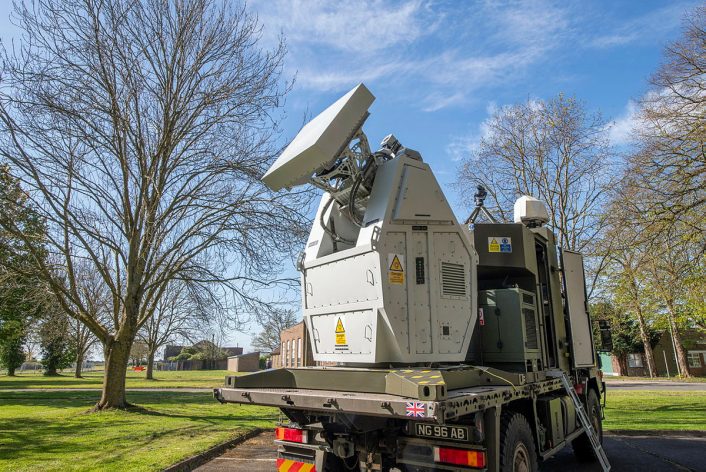
Adding the RF DEW to a layered air defense network would give the British Army the ability to target the types of aerial threats seen with the war in Ukraine. Sky Sabre air defense missile systems would be able to target fast moving aircraft or missile threats, whilst RF DEW would shoot down the more numerous screening drones.
To this end, it has been reported by the UK’s Ministry of Defence that RF DEW only has a range of one kilometer against airborne targets, making it a shorter ranged weapon system than other conventional air defense systems.
Estimated to have a cost of shot at around ‘ten pence’, RF DEW opens up new avenues for air defense against the constantly evolving drone threat. This provides the British Army the ability to take out a large number of drones within a short space of time and at a fraction of the cost, compared to missile-based air defense systems. Notably, it is intended to be used against targets that are resistant to soft kill methods of drone destruction, such as electronic warfare.
Progress with Army RF DEW counter-drone technology demonstrator – with potential for naval use @DefenceES@dstlmod @ThalesUK
See also https://t.co/3HXEI82YAm pic.twitter.com/NBiJAE0ljk
— Navy Lookout (@NavyLookout) April 17, 2025
For example, drones fitted with fiber optic cables, that have been seen in use with growing regularity by forces of Ukraine and the Russian Federation, are likely factoring into industry’s counter drone concepts. The cable allows a constant connection between the operator and the drone, limiting its range but surpassing electronic attacks. Moreover, the UK’s Defence Intelligence estimated that in 2024 Ukraine had to defend against attacks from more than 18,000 drones, highlighting the scale of the threat faced by drones to land forces.
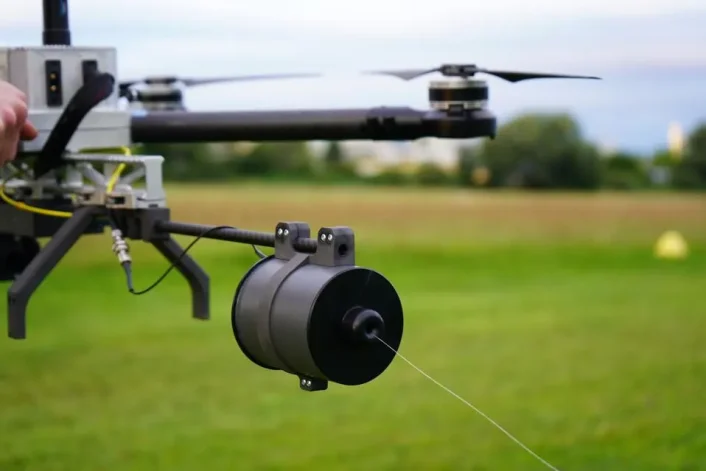
Minister for Defence Procurement and Industry, Rt Hon Maria Eagle MP, said:
“This significant experiment exemplifies the strength of British innovation – driven by our home-grown industry, technology firms and scientific talent. We continue to strengthen our defence sector, adding more cutting-edge capabilities to keep the UK secure at home and strong abroad, while making defence an engine for growth across our towns and cities.”
“It’s critical that given the developments in the world, we accelerate technology out of the lab into military capability”
Dstl with @DefenceES @ThalesUK and partners have developed radio wave weapons at pace to bring the UK operational advantagehttps://t.co/s6DwVC6pbk pic.twitter.com/dIRMWwrPfe
— Dstl (@dstlmod) April 17, 2025
Team Hersa
The RF DEW is developed by Team Hersa, a collaboration between Defence Equipment & Support (DE&S) and the Defence Science and Technology Laboratory (DSTL) to produce three viable energy based air defense systems for the UK’s Armed Forces. They manage the delivery of the demonstrators to the Armed Forces and ensure that the weapons can be successfully integrated onto current aircraft, ships and vehicles.
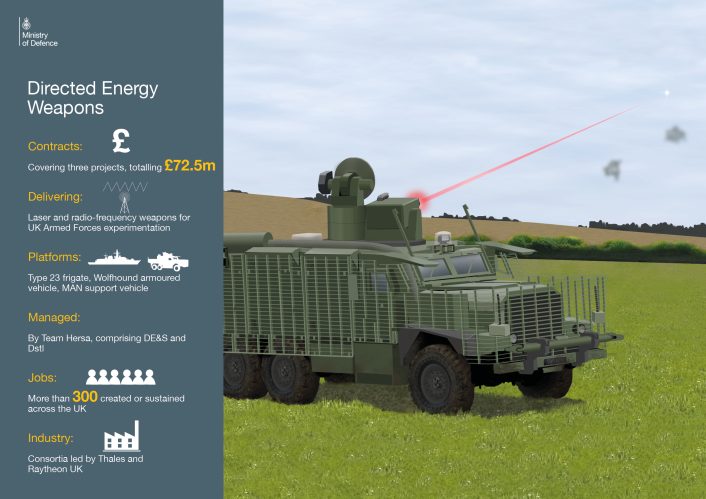
In 2021, three contracts were signed by Team Hersa with the aim of demonstrating three different methods for countering drones, usable by the British Army and Royal Navy.
The first, RF DEW was developed by a consortium led by Thales UK that includes QinetiQ, Teledyne e2v and Horiba Mira.
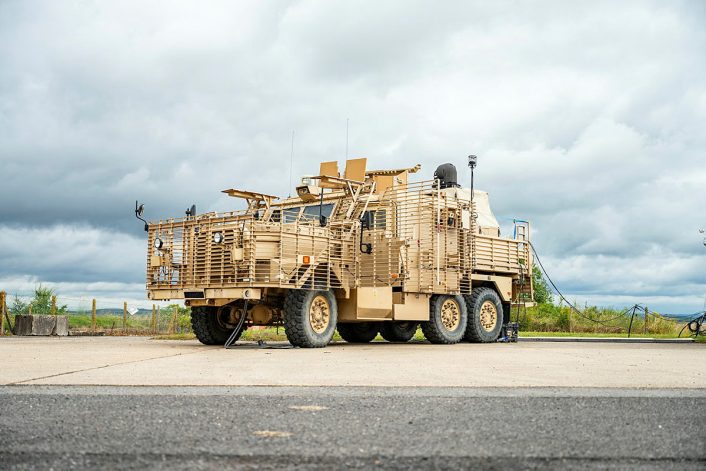
The second contract issued in 2021 was for a Laser Directed Energy Weapon (LDEW) demonstrator to be fitted to a Wolfhound Tactical Support Vehicle, for up to six months of experimentation which took place during 2024. These tests, conducted at DSTL’s range in Porton Down, saw the laser weapon neutralize targets at distances in excess of one kilometer, similarly to the RF DEW, but on an existing British Army armored vehicle.
This video shows a British Army Wolfhound vehicle firing a Laser-Directed Energy Weapon (LDEW). For the first time, scientists and engineers have successfully fired a high-powered laser energy weapon from a British Army combat vehicle at Dstl’s range in Porton Down. pic.twitter.com/ED64bhH3G1
— UK Defence Journal (@UKDefJournal) July 25, 2024
A later test in December, performed by soldiers from 16 Royal Artillery, saw the Wolfhound track down and destroy several hovering targets at the Radnor Range in Wales. The Ministry of Defence will take the knowledge used by the Wolfhound LDEW and the RF DEW to assess the necessary next steps to develop drone countermeasures intended for frontline use by the British Army.
Led by Raytheon UK, the consortium of Fraser Nash, NP Aerospace, LumOptica, Blighter Surveillance Systems and Cambridge Pixel have been involved in developing the weapon under a £16.8 million contract.
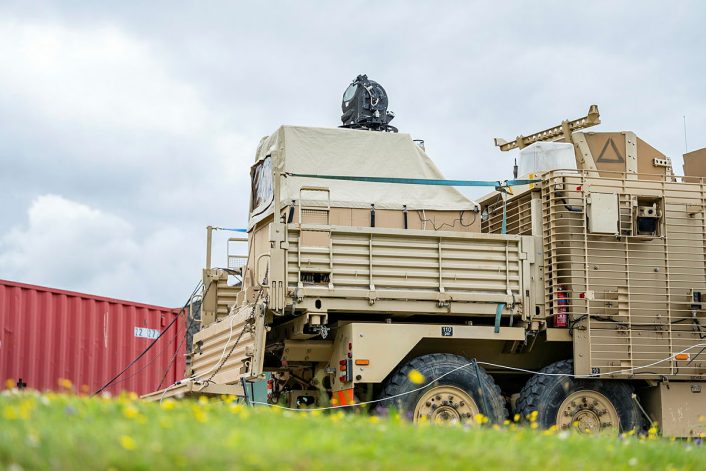
However, these systems were initially supposed to be joined by another LDEW to be trialed on a Royal Navy Duke-class Type-23 frigate by a consortium led by Thales UK. However, it was revealed in January 2024 that this plan had been cancelled following a government reassessment.
It is notable that the cancellation was revealed following the successful test of MBDA’s DragonFire LDEW. This highlights the possibility that funds have been redirected to DragonFire as a result of its successful test, as it may not have been cost effective to test an entirely different LDEW on a platform that will soon leave service, whilst another LDEW is set to be fitted to another warship type. This allows the UK to focus its efforts on a single ship based LDEW saving on costs by preventing a duplication of effort within the UK’s defense industry.
DragonFire Advances
Consequently, it was revealed in March 2025 that the DragonFire program is speeding up its development timetable, with example LDEWs to be fitted onto four of the Royal Navy’s Daring-class Type-45 destroyers by 2027. It was announced during Chancellor of the Exchequer Rachel Reeve’s Spring statement that an extra £2.2 billion was to be allocated to defense to fund development and deployment of directed-energy weapons and AI, with DragonFire being a central program.
The UK Chancellor of the Exchequer announced today that four Royal Navy warships will be fitted with DragonFire laser directed energy weapons by 2027 as part of a £2.2 ($2.8) billion boost to defense spending. The energy needed to fire the DragonFire costs about $10 a shot. pic.twitter.com/mTYk7JYBu1
— U.S. Naval Institute (@NavalInstitute) March 26, 2025
Previously the government was committed to the installation of DragonFire onto a single vessel by 2027 with others to follow, but the new cash inflows allow for four warships to be fitted. However, more are likely to follow as the new City-class Type-26 frigate enters service in subsequent years and it will become a prime target for fitting out with DragonFire as it becomes a more proven system.
Developed by DSTL in partnership with MBDA, Leonardo and QinetiQ, DragonFire is capable of destroying drones and other aerial targets at significant range. The weapon can reportedly strike a £1 coin from one kilometer away, and defeat drones up to five kilometers away with a cost of shot hovering around £10 rather than the ten pence RF DEW.
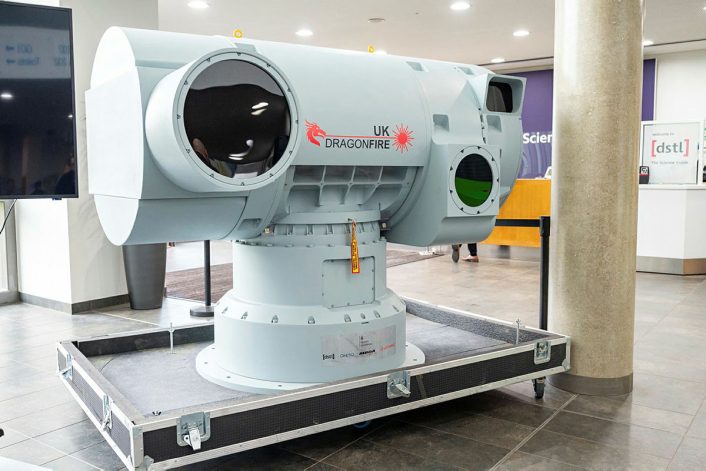
Directed energy weapons are likely to become more prevalent in western militaries as they adapt to changes brought about by the war in Ukraine as well as military action across the Red Sea. Only time will tell if they can live up to the hype, but so far the future looks promising.







